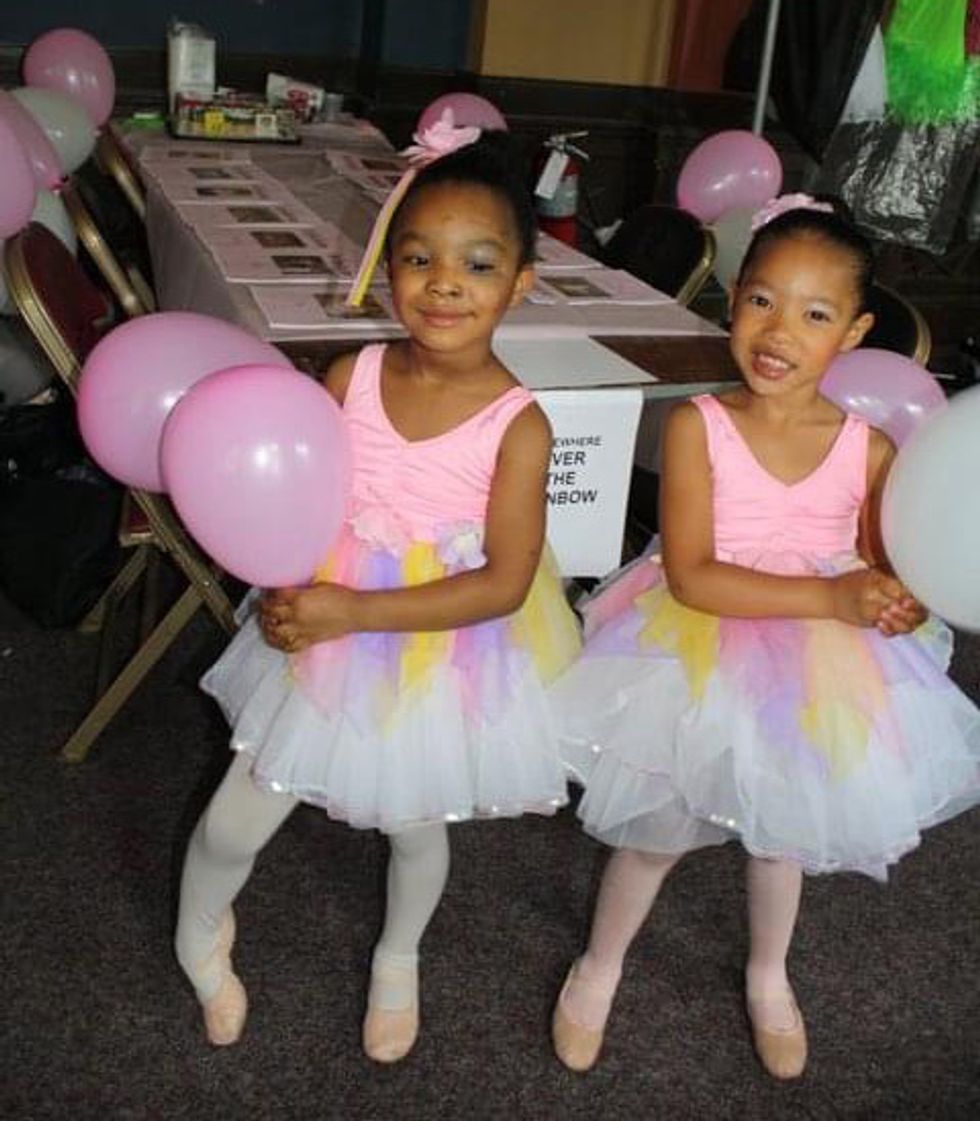
“Water breaks are not Instagram breaks.”
That’s a cardinal rule at Central Virginia Dance Academy, and it applies even to the studio’s much beloved social media stars.
For more than a decade, CVDA has been the home studio of Kennedy George and Ava Holloway, the 14-year-old dancers who became Instagram sensations after posing on the pedestal of Richmond’s Robert E. Lee Monument. Clad in black leotards and tutus, they raise their fists aloft to depict a global push for racial justice.
The morning after the soon-to-go-viral photo shoot, Anne Wash, owner and artistic director of the studio in suburban Richmond, received the images via text from George’s mom.
“I wrote back two words: ‘So powerful,'” Wash recalls. Later, she messaged both of her students and praised them for carrying out one of the studio’s missions: to use art as a force for good in the world.

Holloway and George as creative movement students at CVDA
Photo courtesy CVDA
Soon, the little girls who first danced next to each other at a recital in 2011 weren’t performing just for their parents anymore. They were dancing on the Today Show, appearing in music videos and granting interviews to Inside Edition. Several parents have called CVDA, eager to enroll their children in “the school where Kennedy and Ava dance,” says Wash.
“We are so proud of them,” Wash says. “There are so many elements that made that a powerful picture. As young black females in front of that statue, they stand for change that is needed. I love that they chose to wear tutus, since ballet has not always been welcoming to Black women. The fact that their fists are held high shows that they are young activists, and they are our future.”
Wash founded CVDA in 2008 after dancing as a trainee for a South Carolina ballet company. She wanted to start a family-friendly school in her hometown that would be ballet-focused while also offering classes in other styles. She first taught Holloway in 2009; George enrolled a year later.
Despite the celebrity boost, fall enrollment is down about 35 percent from 2019 due to the coronavirus pandemic, and like many other dance studio owners, Wash is busy upgrading her HVAC system and canceling The Nutcracker. Instead, the studio hopes to put on a production of Cinderella next spring. Both George and Holloway plan to audition; both say they were devastated to miss their spring recitals this year.
While Wash has never specifically advertised to BIPOC families, she suspects there may be a connection between students of color feeling comfortable at CVDA and the positive atmosphere she’s labored to create. When a student performs a combination well, fellow dancers are encouraged to snap their approval. If a student messes up, other students know not to snicker, or to let negative self-talk detract from their own dancing.

Ava Holloway
Marcus Ingram, courtesy Ingram
“Miss Anne is all about respect and love and kindness,” George says.
CVDA faculty member Brandee Green puts it this way: “Miss Anne does not tolerate negativity or nastiness. She does not tolerate bullying. She shuts it down.”
Along with two other CVDA students, Sophia Chambliss and Shania Gordon, George and Holloway have formed a nonprofit dance and advocacy company called Brown Ballerinas for Change. Green serves as a board member, choreographer and ad hoc executive director. (Wash is on the board as well.) “They are all great girls,” says Green. “They are positive, they support one another and they never pose any negativity.”
When requests come in for the girls to perform, it’s Green who vets the opportunity in conjunction with the students’ parents. Most recently, she choreographed a piece set to Trey Songz’s 2020 anthem, “How Many More Times?”
Green is mindful that some presenters might take advantage of the Brown Ballerinas to fill a diversity quota, and researches events before saying yes. “We want to be inclusive, but we also don’t want to be the token,” Green says. “I know what it feels like to be the token.”
Green grew up in Richmond and trained at what is now City Dance Theatre. She was fortunate to have teachers who not only advocated for her as a Black dancer, but nudged her toward teaching at a young age. At Virginia Commonwealth University, however, Green eventually found herself the only Black member on the dance team during her second year—and under intense pressure to never miss a show.
The atmosphere is different at CVDA, Green says. Although she’s the only Black faculty member, the studio “feels like home” to her. Sometimes when studios specifically seek teachers of color, the welcome mat turns out to “not be genuine,” she says. CVDA was different.
“Wash looked at my resumé and didn’t see me as a token,” Green says. Instead, she affirmed Green’s teaching skills, professionalism and talent. “I’ve never felt unwelcome.”
A month before George and Holloway’s photos went viral, Wash sent out a survey to all her faculty members and families in hopes of codifying a list of values for the studio. Number one is “Kindness. Always.” Number five is “Family. A dance family that nurtures and embraces diversity and positivity.”
Holloway especially agrees with that sentiment. “Everyone knows everyone. Everyone cries together. We’re all just like a big family,” she says.
Numbers two, three and four on the CVDA values list ask dancers to pledge their passion for the art form and their pursuit of impeccable technique.
And though it’s not explicitly stated, the pursuit of impeccable technique requires staying off Instagram in the studio, even if you’ve recently been “regrammed” by Beyoncé’s mom. “They know how I feel about cell phones,” Wash says.



